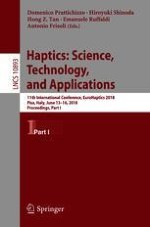2018 | OriginalPaper | Buchkapitel
Judged Roughness as a Function of Groove Frequency and Groove Width in 3D-Printed Gratings
verfasst von : Knut Drewing
Erschienen in: Haptics: Science, Technology, and Applications
Aktivieren Sie unsere intelligente Suche, um passende Fachinhalte oder Patente zu finden.
Wählen Sie Textabschnitte aus um mit Künstlicher Intelligenz passenden Patente zu finden. powered by
Markieren Sie Textabschnitte, um KI-gestützt weitere passende Inhalte zu finden. powered by
